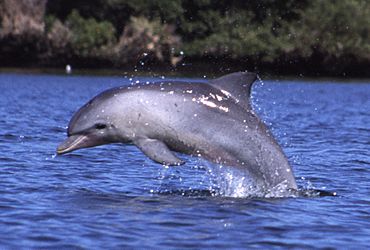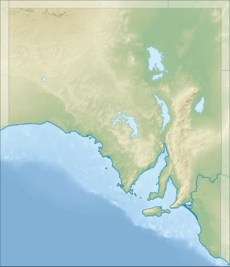Adelaide Dolphin Sanctuary facts for kids
Quick facts for kids Adelaide Dolphin SanctuarySouth Australia |
|
|---|---|
|
IUCN Category IV (Habitat/Species Management Area)
|
|

Dolphin in the Port River
|
|
| Nearest town or city | Port Adelaide |
| Established | 4 June 2005 |
| Area | 118.75 km2 (45.8 sq mi) |
| Managing authorities | Department for Environment and Water |
| Website | Adelaide Dolphin Sanctuary |
| See also | Protected areas of South Australia |
The Adelaide Dolphin Sanctuary is a special marine protected area in South Australia. It is located on the coast of Gulf St Vincent, near Port Adelaide. This sanctuary was created in 2005. Its main goal is to protect a group of Indo-Pacific bottlenose dolphins that live there all the time.
Contents
About the Adelaide Dolphin Sanctuary
Where is the Sanctuary?
The sanctuary covers a long stretch of coastline. It goes from Port Gawler in the north to North Haven in the south. It includes important waterways like the Port Adelaide River and the Barker Inlet.
It also protects Torrens and Garden Islands. The area includes special places like Mutton Cove on the Lefevre Peninsula. This sanctuary protects important natural areas. These include mangroves, seagrass, saltmarshes, and tidal flats. As of 2014, the sanctuary was about 118.75 square kilometers in size.
Why was the Sanctuary Created?
The Adelaide Dolphin Sanctuary was set up in 2005 for two main reasons:
- To protect the dolphin population in the Port Adelaide River and Barker Inlet.
- To protect the natural places where these dolphins live.
The sanctuary also has six important goals it needs to achieve:
- Keep the dolphins safe from harm and improve their protection.
- Protect and restore the key habitats that dolphins need to survive.
- Improve the water quality in the Port Adelaide River and Barker Inlet. This helps the environment and supports healthy life.
- Consider the community's interests. This includes respecting cultural and historical ties to the area. It also means involving people in managing the sanctuary.
- Help people understand why a healthy Port Adelaide River and Barker Inlet are important. This benefits the local communities and everyone.
- Promote sustainable development. This means using and managing the area in a way that protects it for the future.
Who Looks After the Sanctuary?
Since June 2015, the Department of Environment and Water has managed the Adelaide Dolphin Sanctuary. They get help from other government groups and local councils. Many other organizations also help manage the land and water in the sanctuary.
A group of community volunteers, called the ADS Action Group, also helps. This group started in 2012. By 2015, they had 50 registered volunteers. They play a big part in supporting the sanctuary's management.
The Adelaide Dolphin Sanctuary shares its space with other protected areas. These include:
- The Barker Inlet – St Kilda Aquatic Reserve.
- The Port Gawler Conservation Park.
- Most of the St Kilda – Chapman Creek Aquatic Reserve.
- The Torrens Island Conservation Park.
It will also share territory with parts of the Adelaide International Bird Sanctuary. This bird sanctuary is located in areas like Bolivar, Buckland Park, and St Kilda.
Rules for Interacting with Marine Life
The sanctuary is next to the Adelaide Metropolitan Beaches Restricted Area. This area goes from North Haven down to Sellicks Beach. Both the sanctuary and this restricted area have special rules. These rules are about "commercial activities" that involve marine mammals, like dolphins. This means businesses that want to interact with dolphins must follow extra regulations.
The sanctuary is classified as an IUCN Category VI protected area. This means it's a protected area where people can use natural resources in a sustainable way.


